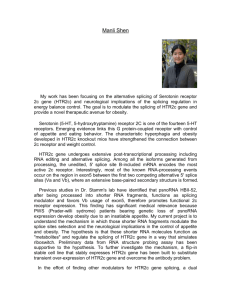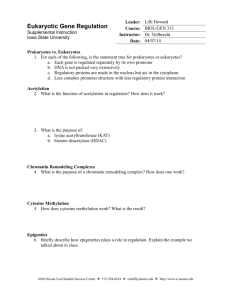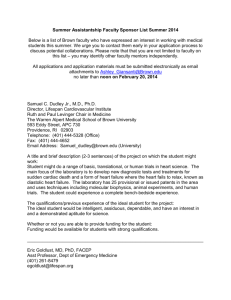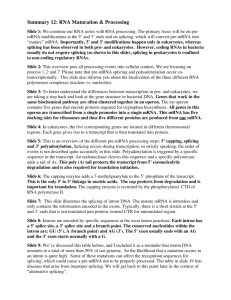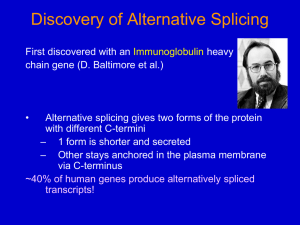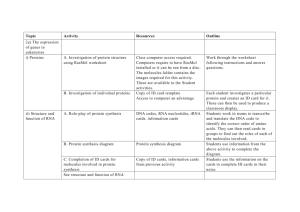Genetic Control of pre-mRNA Splicing and Diseases
advertisement
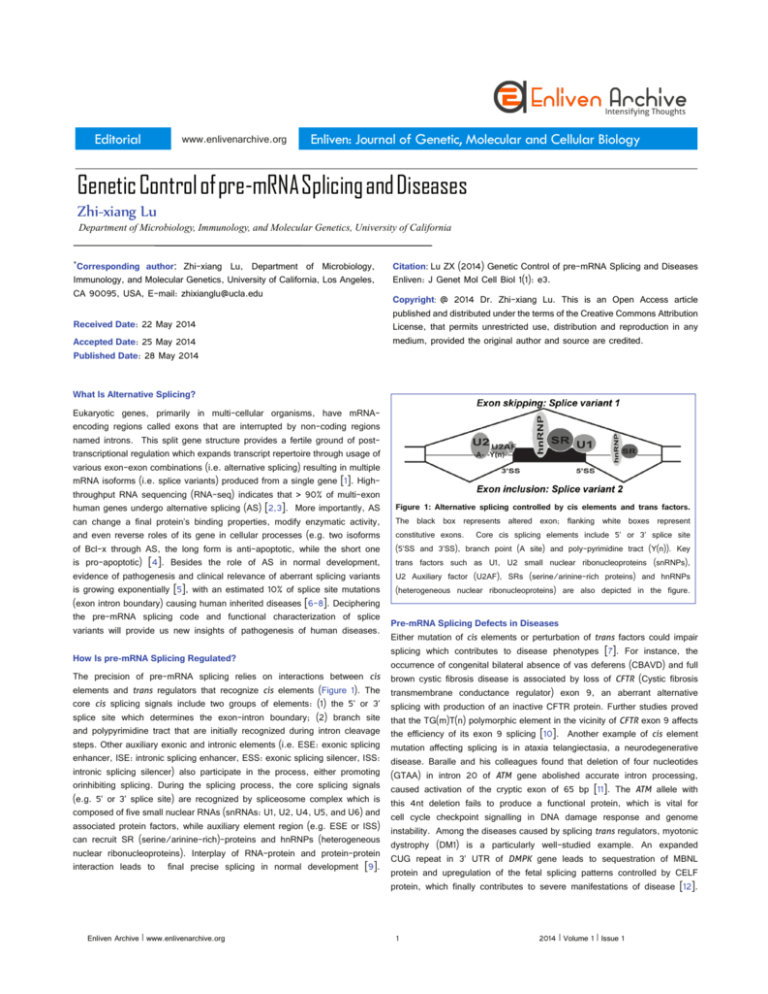
Editorial www.enlivenarchive.org Enliven: Journal of Genetic, Molecular and Cellular Biology Genetic Control of pre-mRNA Splicing and Diseases Zhi-xiang Lu Department of Microbiology, Immunology, and Molecular Genetics, University of California Corresponding author: Zhi-xiang Lu, Department of Microbiology, Immunology, and Molecular Genetics, University of California, Los Angeles, CA 90095, USA, E-mail: zhixianglu@ucla.edu * Received Date: 22 May 2014 Accepted Date: 25 May 2014 Published Date: 28 May 2014 Citation: Lu ZX (2014) Genetic Control of pre-mRNA Splicing and Diseases Enliven: J Genet Mol Cell Biol 1(1): e3. Copyright: @ 2014 Dr. Zhi-xiang Lu. This is an Open Access article published and distributed under the terms of the Creative Commons Attribution License, that permits unrestricted use, distribution and reproduction in any medium, provided the original author and source are credited. What Is Alternative Splicing? Eukaryotic genes, primarily in multi-cellular organisms, have mRNAencoding regions called exons that are interrupted by non-coding regions named introns. This split gene structure provides a fertile ground of posttranscriptional regulation which expands transcript repertoire through usage of various exon-exon combinations (i.e. alternative splicing) resulting in multiple mRNA isoforms (i.e. splice variants) produced from a single gene [1]. Highthroughput RNA sequencing (RNA-seq) indicates that > 90% of multi-exon human genes undergo alternative splicing (AS) [2,3]. More importantly, AS Figure 1: Alternative splicing controlled by cis elements and trans factors. can change a final protein’s binding properties, modify enzymatic activity, The black box represents altered exon; flanking white boxes represent and even reverse roles of its gene in cellular processes (e.g. two isoforms constitutive exons. Core cis splicing elements include 5’ or 3’ splice site of Bcl-x through AS, the long form is anti-apoptotic, while the short one (5’SS and 3’SS), branch point (A site) and poly-pyrimidine tract (Y(n)). Key is pro-apoptotic) [4]. Besides the role of AS in normal development, trans factors such as U1, U2 small nuclear ribonucleoproteins (snRNPs), evidence of pathogenesis and clinical relevance of aberrant splicing variants U2 Auxiliary factor (U2AF), SRs (serine/arinine-rich proteins) and hnRNPs is growing exponentially [5], with an estimated 10% of splice site mutations (heterogeneous nuclear ribonucleoproteins) are also depicted in the figure. (exon intron boundary) causing human inherited diseases [6-8]. Deciphering the pre-mRNA splicing code and functional characterization of splice Pre-mRNA Splicing Defects in Diseases variants will provide us new insights of pathogenesis of human diseases. Either mutation of cis elements or perturbation of trans factors could impair splicing which contributes to disease phenotypes [7]. For instance, the How Is pre-mRNA Splicing Regulated? occurrence of congenital bilateral absence of vas deferens (CBAVD) and full The precision of pre-mRNA splicing relies on interactions between cis brown cystic fibrosis disease is associated by loss of CFTR (Cystic fibrosis elements and trans regulators that recognize cis elements (Figure 1). The transmembrane conductance regulator) exon 9, an aberrant alternative core cis splicing signals include two groups of elements: (1) the 5’ or 3’ splicing with production of an inactive CFTR protein. Further studies proved splice site which determines the exon-intron boundary; (2) branch site that the TG(m)T(n) polymorphic element in the vicinity of CFTR exon 9 affects and polypyrimidine tract that are initially recognized during intron cleavage the efficiency of its exon 9 splicing [10]. Another example of cis element steps. Other auxiliary exonic and intronic elements (i.e. ESE: exonic splicing mutation affecting splicing is in ataxia telangiectasia, a neurodegenerative enhancer, ISE: intronic splicing enhancer, ESS: exonic splicing silencer, ISS: disease. Baralle and his colleagues found that deletion of four nucleotides intronic splicing silencer) also participate in the process, either promoting (GTAA) in intron 20 of ATM gene abolished accurate intron processing, orinhibiting splicing. During the splicing process, the core splicing signals caused activation of the cryptic exon of 65 bp [11]. The ATM allele with (e.g. 5’ or 3’ splice site) are recognized by spliceosome complex which is this 4nt deletion fails to produce a functional protein, which is vital for composed of five small nuclear RNAs (snRNAs: U1, U2, U4, U5, and U6) and cell cycle checkpoint signalling in DNA damage response and genome associated protein factors, while auxiliary element region (e.g. ESE or ISS) instability. Among the diseases caused by splicing trans regulators, myotonic can recruit SR (serine/arinine-rich)-proteins and hnRNPs (heterogeneous dystrophy (DM1) is a particularly well-studied example. An expanded nuclear ribonucleoproteins). Interplay of RNA-protein and protein-protein CUG repeat in 3’ UTR of DMPK gene leads to sequestration of MBNL interaction leads to final precise splicing in normal development [9]. protein and upregulation of the fetal splicing patterns controlled by CELF protein, which finally contributes to severe manifestations of disease [12]. Enliven Archive | www.enlivenarchive.org 1 2014 | Volume 1 | Issue 1 Interestingly, disease severity can by modulated by the interplay of cis mutation and trans factor perturbation. One splicing genetic modifier of SCN8A gene has been characterized in mice. In C3H mice, a 4nt deletion (GTAA) close to 5’ splice site of SCN8A exon 3 results in skipping of both exon 2 and exon 3 in most transcripts resulting in only 10% of the transcripts beingcorrectly spliced. C57BL/6J mice, in addition to the 4nt deletion in SCN8A gene, have a stop mutation in SCNM1 gene whose protein product acts as a splicing factor controlling SCN8A splicing patterns. With both the deletion in SCN8A and the mutation in SCNM1, only 5% of SCN8A will be correctly spliced in C57BL/6J mice. This small (10% vs. 5%) splicing difference however leads to dramatically distinct disease phenotypes. C3H mice only have a disorder of chronic movement while C57BL/6J mice develop a severe lethal neurological disease [13]. Such above evidence underscores the roles of AS in inherited diseases. In addition, aberrant splicing events observed in cancers through alteration of splicing factor concentration or localization are reviewed extensively elsewhere [14,15]. Perspectives and Challenges of Studying Defective Splicing Despite widespread use of AS in both major physiological and pathological aspects of cell biology, we still do not understand the function of most splice variants. Without functional data, we cannot decipher if these aberrant splicing events play a role in initiation and/ or development of diseases or whether they are just “passenger” isoforms. In fact, functional characterization of certain transcript on a splicing level involves more technical difficulties than the gene level. For instance, confounding factors cannot be ruled out, such as global gene expression change, or additional isoform product from cryptic exon usage when the target exon splicing of interest is blocked. Moreover, due to the function redundancy of splicing regulatory proteins it is extremely difficult to get clear regulatory architecture of certain defective splicing. Thanks to cutting-edge technologies such as deep RNA sequencing and clinical whole exome sequencing, we are now able to access the potential links between AS, DNA variants and disease traits [16]. Furthermore, many splicing regulatory elements that promote or inhibit splicing have been identified in in vitro random oligonucleotide library screening [17,18]. Currently, HITS-CLIP (high throughput sequencing by crosslinking immunoprecipitation) provides us a refined interaction map between mRNA and RNA binding proteins across diverse tissues and cell types [19,20]. All above comprehensive studies are facilitating many important investigations of AS regulation. For example, globally correlating AS to RNA binding map of certain splicing factor scan gain important insights into how RNA-protein interactions affect splicing, integration of hundreds of putative splicing regulatory elements/ feature can predict tissue-specific AS patterns [21,22]. Meanwhile, antisense oligonucleotide targeting splice sites have been developed as a modulator of pre-mRNA splicing, a powerful approach to dissect function role of splicing variants [23]. Some promising antisense oligonucleotides are already in clinical trials, for instance AVI-4658 is in clinical trials testing for missplicing disorder in Duchenne Muscular Dystrophy [24]. We believe that this RNA splicing topic will deepen the impression of AS roles in diseases and foresee the AS biomarkers as the effective therapeutic targets. References 1. Nilsen TW, Graveley BR (2010) Expansion of the eukaryotic proteome by alternative splicing. Nature 463: 457-463. 2. Pan Q, Shai O, Lee LJ, Frey BJ, Blencowe BJ (2008) Deep surveying of alternative splicing complexity in the human transcriptome by highthroughput sequencing. Nat Genet 40: 1413-1415. 3. Wang ET, Sandberg R, Luo S, Khrebtukova I, Zhang L, et al. (2008) Alternative isoform regulation in human tissue transcriptomes. Nature 456: 470-476. 4. Kelemen O, Convertini P, Zhang Z, Wen Y, Shen M, et al. (2013) Function of alternative splicing. Gene 514: 1-30. 5. Eswaran J, Horvath A, Godbole S, Reddy SD, Mudvari P, et al. (2013) RNA sequencing of cancer reveals novel splicing alterations. Sci Rep 3: 1689. 6. Krawczak M, Thomas NS, Hundrieser B, Mort M, Wittig M, et al. (2007) Single base-pair substitutions in exon-intron junctions of human genes: nature, distribution, and consequences for mRNA splicing. Hum Mutat 28: 150-158. 7. Wang GS, Cooper TA (2007) Splicing in disease: disruption of the splicing code and the decoding machinery. Nat Rev Genet 8: 749-761. 8. Stenson PD, Mort M, Ball EV, Howells K, Phillips AD, et al. (2009) The Human Gene Mutation Database: 2008 update. Genome Med 1:13. Enliven Archive | www.enlivenarchive.org 9. Chen M, Manley JL (2009) Mechanisms of alternative splicing regulation: insights from molecular and genomics approaches. Nat Rev Mol Cell Biol 10: 741-754. 10. Groman JD, Hefferon TW, Casals T, Bassas L, Estivill X, et al. (2004) Variation in a repeat sequence determines whether a common variant of the cystic fibrosis transmembrane conductance regulator gene is pathogenic or benign. Am J Hum Genet 74: 176-179. 11. Pagani F, Buratti E, Stuani C, Bendix R, Dork T, et al. (2002) A new type of mutation causes a splicing defect in ATM. Nat Genet 30: 426429. 12. Orengo JP, Chambon P, Metzger D, Mosier DR, Snipes GJ, et al. (2008) Expanded CTG repeats within the DMPK 3’ UTR causes severe skeletal muscle wasting in an inducible mouse model for myotonic dystrophy. Proc Natl Acad Sci U S A 105: 2646-2651. 13. Buchner DA, Trudeau M, Meisler MH (2003) SCNM1, a putative RNA splicing factor that modifies disease severity in mice. Science 301: 967-969. 14. David CJ, Manley JL (2010) Alternative pre-mRNA splicing regulation in cancer: pathways and programs unhinged. Genes Dev 24: 23432364. 2 2014 | Volume 1 | Issue 1 15. Oltean S, Bates DO (2013) Hallmarks of alternative splicing in cancer. Oncogene. 16. Martinez FJ, Lee JH, Lee JE, Blanco S, Nickerson E, et al. (2012) Whole exome sequencing identifies a splicing mutation in NSUN2 as a cause of a Dubowitz-like syndrome. J Med Genet 49: 380-385. 17. Wang Z, Rolish ME, Yeo G, Tung V, Mawson M, et al. (2004) Systematic identification and analysis of exonic splicing silencers. Cell 119: 831-845. 18. Fairbrother WG, Yeh RF, Sharp PA, Burge CB (2002) Predictive identification of exonic splicing enhancers in human genes. Science 297: 1007-1013. 19. Licatalosi DD, Mele A, Fak JJ, Ule J, Kayikci M, et al. (2008) HITS-CLIP yields genome-wide insights into brain alternative RNA processing. Nature 456: 464-469. 20.Yeo GW, Coufal NG, Liang TY, Peng GE, Fu XD, et al. (2009) An RNA code for the FOX2 splicing regulator revealed by mapping RNAprotein interactions in stem cells. Nat Struct Mol Biol 16: 130-137. 21. Witten JT, Ule J (2011) Understanding splicing regulation through RNA splicing maps. Trends Genet 27: 89-97. 22.Barash Y, Calarco JA, Gao W, Pan Q, Wang X, et al. (2010) Deciphering the splicing code. Nature 465: 53-59. 23.Kole R, Krainer AR, Altman S (2012) RNA therapeutics: beyond RNA interference and antisense oligonucleotides. Nat Rev Drug Discov 11: 125-140. 24.Kinali M, Arechavala-Gomeza V, Feng L, Cirak S, Hunt D, et al. (2009) Local restoration of dystrophin expression with the morpholino oligomer AVI-4658 in Duchenne muscular dystrophy: a single-blind, placebo-controlled, dose-escalation, proof-of-concept study. Lancet Neurol 8: 918-928. Submit your manuscript at http://enlivenarchive.org/submit-manuscript.php New initiative of Enliven Archive Apart from providing HTML, PDF versions; we also provide video version and deposit the videos in about 15 freely accessible social network sites that promote videos which in turn will aid in rapid circulation of articles published with us.
